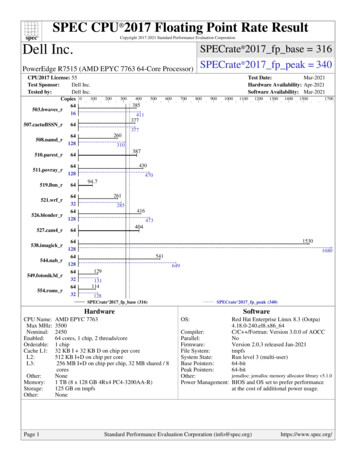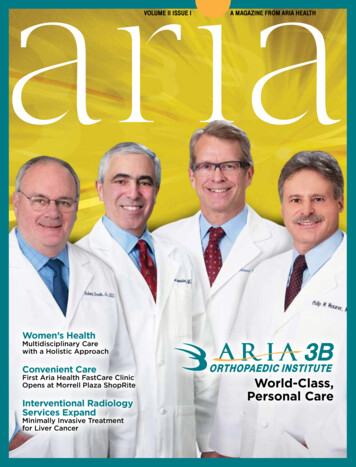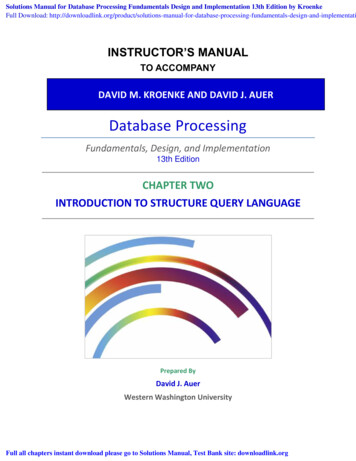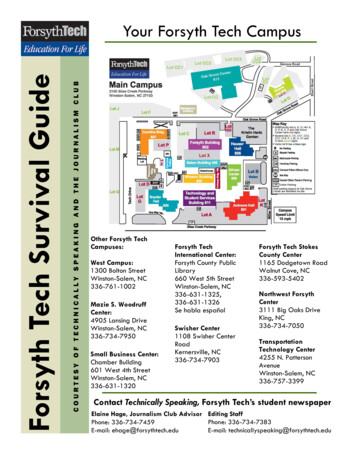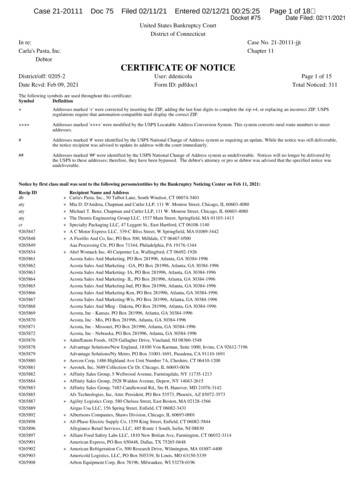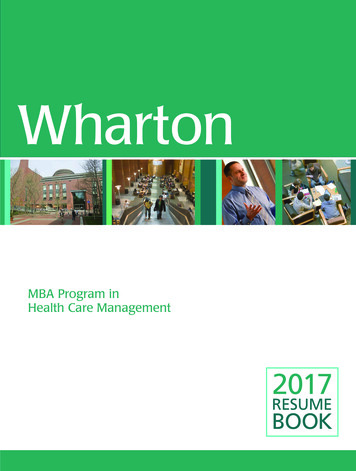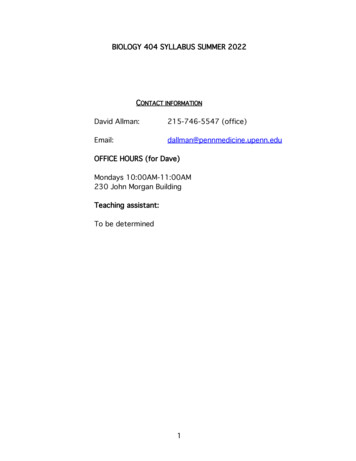
Transcription
BIOLOGY 404 SYLLABUS SUMMER 2022CONTACT INFORMATIONDavid Allman:215-746-5547 (office)Email:dallman@pennmedicine.upenn.eduOFFICE HOURS (for Dave)Mondays 10:00AM-11:00AM230 John Morgan BuildingTeaching assistant:To be determined1
BIOLOGY 404BASIC IMMUNOLOGYTuesdays - 5:00 TO 8:50 PMLECTURES HELD VIA ZOOM:https://sasupenn.zoom.us/j/6837392595?pwd cU9meCtrb1I0MGI2UitHaHpxTlRSdz09COURSE GOALS: The goals of this course are several: First, I hope to introduce you tobasic principles and current concepts in the field of immunology. Second, I would like tostimulate your thinking, especially from an experimental standpoint, about how theseprinciples and concepts are formed. Finally, I hope you will leave with a foundation, forboth the field of immunology and general experimental approaches, which will enableyou to learn more on your own, through critical appraisal of the literature.COURSE DESCRIPTION: The course will begin with a general overview of immunity,followed by in-depth considerations of the underlying cellular, molecular, and geneticevents. Finally, later discussions will focus upon more specialized issues in immunology,such as disease states involving the immune system, as well as particularly interestingproblems in modern immunology.EXAMS: There will be two exams, EACH WITH A TAKE-HOME AND AN IN-CLASSPORTION. The exact format of these will be announced prior to each exam, but will beprimarily essay or brief answer questions. Take-home exams will be distributed twoweeks before the in-class exam dates and must be turned in along with the in-class exam.Take-home exams will not be accepted late.QUIZZES: There will be an open book quiz that is due at the beginning of every sessionat 5pm. These are mainly for self-evaluation and to introduce new ideas to you, and canonly improve your final grade. Each will be corrected and returned by the next class. Eachquiz will become available 34 hours before it is due.ONLINE THREADED DISCUSSION GROUPS: We will be utilizing the Canvas web site(https://canvas.upenn.edu/) in which we will be able to discuss, as a group, basicprinciples and problems that guide our current understanding of the immune system.Each week the class will be given a question or problem to work on as a group. For someweeks, I may also pose a question or describe an experiment in class, and then eachstudent will be expected to attempt to address the issue online. These are threadeddiscussions in the sense that all members of the class will be able to view, and respond to,comments made by others in the class or within their specified group. In addition, thecourse director and teaching assistant may guide the discussion when appropriate. Wemay also have certain "guests" with expertise in a relevant area add comments. I thinkthat these exercises will be fun and will add to your understanding of scientific principlesand your ability to learn from your colleagues. Participation is mandatory: Roughly 33%of your final grade will be derived from your participation, or lack thereof, in this activity.2
SCHEDULE: Each session will be divided as follows:* Up to the first 20 minutes will be devoted to an open discussion of the previouslecture/homework problems/quiz questions.*A 10-minute break.READINGS: Readings in the primary text are given in the table on page 6. I stronglysuggest you use these, as you see fit, to strengthen your grasp and broaden yourperspective of the concepts conveyed in class.TEXT: The recommended text is Immunobiology 8th or 9th edition, by Janeway et al.,published by Garland Publishing, Inc. Copies are available in the University bookstore,Amazon, you name it . . .ATTENDANCE: Attendance is not required, although participation in the quizzes willallow us to determine if excessive absences might be the basis for poor performance and could mitigate against any special consideration if this is the case.3
GRADINGThe following “straight scale” grading system will be used: 97 A 93-96 A90-92 A-87-89 B 83-86 B80-85 B-77-79 C 73-76 C70-72 C- 70 D 60 FThroughout the course you may collect chips. At the end, you cash in your chips, andyour grade will be computed by taking your total "chips" and dividing by 3.CHIP SOURCES AND MAXIMAExams: Each exam has two parts: an in-class portion consisting of short answer questionssimilar to the quiz questions you have had, and a take-home portion consisting of threesets of essay questions. On each take-home exam, the question sets will be progressivelymore challenging. You may answer as many as one question from each set. The in-classportion of each exam is worth a maximum of 55 chips. The take-home questions are worth 15chips/question. Thus, on each exam, the maximum from each take-home exam is 45 chips.Threaded Discussion Groups: There will be 8 threaded discussions/debates, each worth10 chips for a total of 80 possible chips. At the end of the class your grade will benormalized to 100. Each week you will be graded on your participation in these onlinediscussions and debates of current topics in immunology. Each discussion/debate will beposted by 10pm on the night of a lecture. Responses from each individual registered forthe class are due by 10pm the following Monday.Quizzes: There will be 9 quizzes, each worth 10 chips. At the end of the course, 20% ofyour quiz chips are added to your other chips PRIOR TO division by 3. The maximumchips from quizzes is thus (90 X .20), or 18. Therefore the maximum the quizzes can addto your final grade is 18/3, or 6.0.SUMMARY OF CHIP SOURCES AND MAXIMAQuizzesThreaded Discussions(normalized)Exam I 2 week portionExam I 24-hour portionExam II 2 week portionExam II 24-hour portion1810045554555MAX POSSIBLETOTAL CHIPS318MAX POSSIBLEFINAL SCORE106(318/3)4
LECTURE SCHEDULEMay 24INTRODUCTION TO BASIC IMMUNOLOGYKINETICS AND PROPERTIES OF IMMUNE RESPONSES AB STRUCTURE AND MOLECULAR BASIS FOR AB SPECIFICITYMay 31INTRODUCTION TO CELLULAR IMMUNOLOGYCELLS AND TISSUES OF THE IMMUNE RESPONSECONTRAST: INNATE AND ADAPTIVE IMMUNE MECHANISMSCLONAL SELECTION HYPOTHESIS & RECEPTOR DIVERSITYJune 7THE GENETIC BASIS FOR AG-RECEPTOR DIVERSITYMECHANISMS OF AG RECEPTOR DIVERSITYB CELL DEVELOPMENT - LINKING DEVELOPMENT WITH RECEPTOR DIVERSITYJune 14THE B CELL RESPONSE, EFFECTOR FUNCTIONS MEDIATED BY ANTIBODIESTHE GERMINAL CENTER & AFFINITY MATURATIONANTIBODY ISOTYPES, THEIR GENERATION AND FUNCTIONANTIBODY MEDIATED EFFECTOR FUNCTIONS AND COMPLEMENTCOMMUNICATION BETWEEN B CELLS AND INNATE IMMUNE CELLSHAND OUT TAKE-HOME EXAM #1June 21TOOLS, TESTS AND EXPERIMENTAL SYSTEMS USED IN IMMUNOLOGYJune 28MID-TERM IN-CLASS EXAM - TAKE-HOME EXAM #1 DUEJuly 5THE MHC AND T CELL BIOLOGYALLOREACTIVITY AND IMMUNE RESPONSE GENES"MHC RESTRICTION" AND ITS IMPLICATIONSTHE MHC, A GENETIC LOCUS CONTROLLING T-DEPENDENT IMMUNE RESPONSESJuly 12CONTROL OF T CELL-MEDIATED IMMUNITYPOSITIVE SELECTION OF IMMATURE T CELLSANTIGEN RECOGNITION BY T-CELLS - STRUCTURE OF THE T CELL RECEPTORANTIGEN PROCESSING AND PRESENTATIONCOSTIMULATIONCYTOKINES AND T CELL SUBSETSJuly 19THE PROBLEM OF SELF VERSUS NON-SELF DISCRIMINATIONB AND T CELL DEVELOPMENT VIS A VIS TOLERANCEMECHANISMS OF PERIPHERAL TOLERANCEHAND OUT TAKE-HOME EXAM #2July 26INNATE IMMUNITY AND ITS RELATIONSHIP TO ADAPTIVE IMMUNITYINFLAMMATORY CYTOKINESPATTERN RECOGNITION MECHANISMSIMMUNE MEMORYAugust 2FINAL IN-CLASS EXAMINATION - TAKE HOME EXAM 2 DUE5
SUGGESTED READINGSLECTURETOPIC1Intro / Kinetics / Ab-Ag interactions2Cells and tissues / developmentCell interactions / clonal selectionInnate immunity3Genetic basis for receptor diversity45Ab isotypes and isotype switching /germinal center reactionAntibody-mediated effector mechanismsImmunologist’s Toolbox6MHC and T cell receptor function7T cell mediated immunity8T Lymphocyte development andB and T Cell toleranceIntegrating innate and adaptive immunity96PAGES INJANEWAY8TH EDITIONPages 1-10,18-22; SkimChapter 1Pages 127-138;Pages 1-30Chapter 11Chapter 1 (all);Pages 157-168Pages 48-71;Chapter 10;Pages 179-189Appendix 1Pages 652-654;Pages 169-173Chapter 6Pages 138-151Chapter 9PAGES INJANEWAY9TH EDITIONPages 1-24Pages 141-151Chapter 2 (all)Pages 11-24(repeat)Pages 174-186Pages 296-313Pages 191-198Chapter 10Skim pages740-779Pages 214-242Pages 152-170Pages 328-340Pages 282-290Chapter 9Chapter 8Chapter 15Chapter 11Chapter 11
LECTURE 1SESSION I ADVANCE ORGANIZER:Most animals have protective systems to survive attack by foreign materials(pathogens, etc.). Some are "constitutive" mechanisms, serving to protectagainst any type of invasion, such as the keratinized layer of the epidermis andassociated secretions. Others, including the immune system of vertebrates, areINDUCIBLE - becoming active only after the offending agent is present.These protective mechanisms show different degrees of specificity. Some arevirtually nonspecific; i.e.; they act against any and all offending agents in the samefashion. Others, again including the immune system, are SPECIFIC - possessing theability to recognize subtle differences between different offending agents,tailoring the response to these differences.Finally, the immune system displays two additional important properties: MEMORY,implying that upon a second or further exposure to a given foreign substance, theimmune system responds more rapidly and more avidly; and NONRESPONSIVENESS TO SELF, implying that structures which are a normal part ofthe host organism are not attacked and destroyed by its own immune system,even though they could be attacked by the immune system of an individual inwhich they were not "self".7
I. INTRODUCTION TO BASIC MOLECULAR AND CELLULAR IMMUNOLOGYA. PROTECTIVE MECHANISMS - GENERAL CONSIDERATIONS1. PROTECTIVE MECHANISMS EXIST IN MOST ANIMAL FORMS.a. SPECIFIC vs NON SPECIFICnonspecific mechanisms - not cognitivekeratinized skin layer inflammation processesspecific -requires recognitionb. INDUCIBLE vs CONSTITUTIVE PROTECTIVE SYSTEMSconstitutive - always active, require no stimulusinducible - require an activating stimulusc. IMMUNITY AMONG VERTEBRATESB. IMMUNITY IS A PROTECTIVE MECHANISM1. The notion of immunity is not new. That disease exposure could leadto subsequent disease resistance was recorded by the ancient Greeks.Accounts of deliberate exposure to disease-producing materials as a meansof inducing resistance occur throughout history in many cultures. Perhapsthe best known (but by no means the first) is the account of Edward Jenner,who defended the practice of smallpox vaccination. It is now evident thatimmunity is mediated by specialized organs, cells, and molecules, whichtogether produce the phenomena described by these early observers.2. The basis for immunity is the recognition, at a sub-molecular level, ofsubtle structural differences between "self" and "non-self". It is this abilityto distinguish small molecular differences that makes the molecules andcells of the immune system good candidates for use as specific molecularprobes in research, therapeutics, diagnostics, and industry.8
C. AN EXPERIMENT CHARACTERIZING IMMUNE RESPONSES1. The immune system is characterized by four major properties: inducibility,specificity, memory, and non-responsiveness to self. These properties reflect the cellularand molecular events that comprise the immune response. Your own tetanusvaccination serves as an example to demonstrate these properties:a. INDUCIBILITYInducibility is inferred from the observation that immunity is not a constitutivephenomenon: i.e.; exposure to an immunogenic agent, or antigen, must occur beforeimmunity is expressed.b. SPECIFICITYSince immunization with one substance does not provide immunity to another,specificity is inherent in the immune response. This property is one reason that theimmune response is so well suited to the production of specific tests and tools for thedetection of small molecular differences.c. "MEMORY"The property of memory may be deduced from the observation that subsequent toinitial antigen exposure, evidence of immune activity is more rapidly detectable uponre-exposure.d. NON-RESPONSIVENESS TO SELFNon-responsiveness to self, one of the most important yet puzzling properties of theimmune system, is clearly requisite for a system designed to act against substances byrecognizing their molecular structures. Obviously, if such a system were reactive tomolecular structures of the host, serious injury or death might result. Indeed, theserious clinical symptoms of diseases characterized by immune reactivity to one's ownmolecular constituents (autoimmune diseases) are evidence of this. How the immunesystem manages to distinguish "self" from "non-self" remains one of the majorproblems in immunology.9
SESSION II ADVANCE ORGANIZER:The immune system operates via two general mechanisms.One involves the production of molecules which appear in the tissue fluids (the'humors'). These molecules specifically interact with the offending agent todestroy or inactivate it. This is called the HUMORAL IMMUNE RESPONSE.The second involves the activation of cells (as opposed to soluble molecules)which attack other cells bearing foreign materials, and is thus termed CELLULARIMMUNITY.Immune responses follow characteristic kinetics, if immune activity is plotted asa function of time following antigen administration.An understanding of the antibody molecule and antibody-antigen interactionsshows how specificity can be explained at a molecular level. The precipitin reactionmay be used to demonstrate the properties of antibody-antigen interactions andmake inferences about the general structure of antibodies.The major take-home message from the precipitin reaction experiment is thathumoral immune responses are inducible, specific. The major point of hapteninhibition of precipitation is that antibody-antigen interactions are reversible andthat antibodies are multivalent.10
I. INDUCTION AND EFFECTOR PHASES OF IMMUNE RESPONSESA. An immune response may be operationally divided into two phases:1. The induction phase. This involves specific interactions between structures on theantigen molecule and receptors on the cells which mediate immunity. Theseinteractions stimulate the cells to differentiate and divide. This antigen-inducedactivation of cells is the first step in an immune response.2. The effector phase. This entails direct interaction of the immune system's moleculesand cells with an antigen, as well as the activation of other cellular and molecularsystems, which collectively serve to destroy and remove the antigen.II. 'HUMORAL' vs 'CELL MEDIATED' IMMUNE RESPONSESA. The immune system acts via two major effector mechanisms.1. The humoral immune response is characterized by the appearance of solublemolecules, called antibodies, in the serum (the fluid constituent of blood) of theimmunized individual. Antibodies are proteins which interact specifically withstructural features on the surface of the antigen.2. Cell mediated immunity results in the activation of cells which do not secretesoluble antigen-specific mediators of immunity, but instead directly lyse other cellsexpressing foreign materials upon their surface.B. In addition, the immune system contains a large regulatory component consistingof cells, molecules and receptors, which serve to positively or negatively regulate theactivities of these two major effector arms of the response.11
III. KINETICS OF IMMUNE RESPONSESA. IMMUNE RESPONSES FOLLOW CHARACTERISTIC KINETICSFIG. 1Immune responses follow characteristic kinetics. After the first, or primary, exposure to antigen,several days pass before effector activity (either antibody or cell mediated immunity) can bedetected. Following this, there is a steady rise, plateau, and subsequent fall in specific immuneactivity. Upon secondary exposure, however, several differences are noted. First, the lag period isconsiderably shorter. Second, the activity rises at a more rapid rate and reaches higher levels thanin the primary response.12
B. COMPARE AND CONTRAST PRIMARY vs SECONDARY RESPONSESThe differences between the primary and secondary response have severalimplications for immunity, as well as for any attempt to manipulate orexploit the immune system's capabilities or components.1. The primary response, because of its slower rise time, is rarely able toprevent disease if the offending antigen is pathogenic. The primaryresponse may, however, help in the recovery from disease and therestriction of disease-producing materials to a particular site.2. The secondary response will frequently prevent any overt symptoms ofdisease, because the offending agent is rendered innocuous by the immunesystem's effector functions before these symptoms are apparent. This is thebasis for vaccination - the deliberate exposure of individuals tononpathogenic forms of materials that usually cause disease. Thisintentional exposure 'primes' the subject, so that subsequent exposure willinduce a secondary, disease-preventing response.C. WHAT CELLULAR AND MOLECULAR EVENTS UNDERLIE THIS?These kinetic differences between primary and secondary responses reflecta preferential expansion and differentiation of the cells within the immunesystem that are specifically reactive with the immunizing anti- gen. Most ofthese changes occur during the primary response. Thus, upon secondaryexposure this already expanded, specific armamentarium reachesdetectable levels of activity more rapidly.IV. THE MOLECULAR BASIS FOR SPECIFICITY IN HUMORAL RESPONSESA. THE ANTIBODY MOLECULEUnderstanding the chemical nature of antibodies and their interactions with antigen isimportant for several reasons. First, their structure demonstrates how exquisitespecificity may be expressed at a molecular level. Second, they provide a conceptualframework for more general considerations of molecular recognition in solution and atcell surfaces.B. EXPERIMENTAL APPROACH TO UNDERSTANDING Ab STRUCTURE:1. PRECIPITIN REACTIONAntigen-antibody interactions may be demonstrated and studied by a variety of tests.Detailed descriptions of all such tests are beyond the scope of this course. Thefollowing discussion presents the fundamental properties of antibody-antigeninteractions using an elegantly simple test, the precipitin reaction. The results of this testmake many inferences about the nature of the antibody molecule's structure andchemical behavior.13
C. IMMUNIZATION - PRACTICAL ISSUESDEFINITIONSANTIGEN - Any substance which will induce a specific immune response. whenadministered to an immunocompetent individual.HAPTEN - A substance, frequently a small organic group, which cannot itself act as anantigen , but which will serve as an antigenic determinant when coupled to a larger,"carrier", molecule. [e.g.; in the antigen, DNP-BSA (dinitrophenyl - bovine serumalbumin), the DNP group is the hapten and the BSA is the carrier molecule. The entirecomplex is the antigen.]CARRIER - A substance, usually a large molecular weight protein, to which smallgroups (haptens) may be coupled in order to make them antigenic.ANTIGENIC DETERMINANT - Any small region of a molecule which forms a 3dimensional array of structure and charge which will be recognized and bound by an antibodycombining site. Note that unlike the above entities, this term has no meaning exceptwhen spoken of in the context of a particular antibody’s combining site.D. A SIMPLE PRECIPITIN REACTION SHOWS:INDUCIBILITYThere is no precipitation formed in the pre-immune serum sample, only in the samplesafter immunization.SPECIFICITYAs the molecular vehicle of humoral immunity, it stands to reason that the interaction ofan antibody with antigen displays specificity. (This specificity is a function of the aminoacid composition within particular areas of the antibody molecule, as seen below. Thecombining site thus formed presents a particular spatial array of structure and chargewhich is available to interact with small structures on the antigen surface.) In the precipitintest we are doing, the specificity is shown by a lack of reactivity against materials whichwere not used to immunize.14
HETEROGENEITYThis is actually more a property of the humoral immune response in general than ofantibody-antigen interactions per se. In general, most antigens elicit a large variety ofantibodies when used to immunize an individual. For example, even very small organicmolecules such as 2-,4-dinitrophenyl (DNP), if coupled to an appropriate carrier molecule,will elicit literally thousands of different antibodies - each of which binds DNP withmeasurable affinity but each of which is slightly different than the other. This extensiveHETEROGENEITY allows a great deal of selectivity within immune responses, since it isthought that those antibodies of higher affinity will gradually predominate as antigenlevels decrease within the individual. Indeed, a gradual increase in the average affinity ofan antisera is observed as the primary response proceeds and presumably reflects thisprocess. Heterogeneity is shown in our example by the reaction of the antisera with thehapten - even on a carrier which we know there are no antibodies against, as well as withthe carrier molecule we used in the immunization - even when no hapten molecules arecoupled to it.E. HAPTEN INHIBITION SHOWS:REVERSIBILITYPerhaps the most important property (at least in terms of your understanding what theterm “specificity “ means in an immunological sense) of antibody-antigen interactions istheir reversibility. This property is often ignored by veteran as well as noviceimmunobiologists - and is frequently rediscovered by experience.Reversibility of antibody-antigen interactions may be demonstrated by various types ofcompetitive inhibition experiments. The reversibility of antibody-antigen interactionsindicates that the binding of an antibody to its ligand is a non-covalent process mediatedprimarily by charge interactions and other weak chemical forces. This in turn indicatesthat antigen-antibody interactions are an equilibrium process, and may be described (asany other equilibrium process) by the law of mass action. Thus, for any particularantibody-antigen combination, it should be possible to derive an affinity constant basedupon the strength of the interaction between the combining site and the ligand.MULTIVALENCY REQUISITE FOR PRECIPITATIONSince monovalent ligand will competitively inhibit the precipitation of complexes thatoccurs when multivalent ligands are used, it may be inferred that precipitation requiresmultivalent interactions, and more importantly, that antibody molecules are likely to havemore than one combining site per molecule.15
SESSION III ADVANCE ORGANIZERImmunoglobulins are large multi-chain glycoproteins. Each molecule has twoidentical heavy and two identical light chains. The amino terminal portions of bothtypes of chains are highly variable in amino acid sequence, and are where thecombining site for antigen is formed. The carboxy-terminal portions of each chainare fairly constant from molecule to molecule and dictate effector functions.Several general classes of heavy and light chain constant regions exist, and definethe heavy and light chain "isotypes".IMMUNOGLOBULIN STRUCTUREI. GENERAL FEATURESAll immunoglobulins consist of at least one basic four-chain monomer. Each monomercontains two identical large, or heavy, chains; and two identical small, or light, chains. Theheavy chains have a molecular weight of 50K daltons, and the light chains have amolecular weight of 25K daltons. Thus, each such four-chain molecule has a weight ofabout 150Kd. The chains are linked by interchain disulfide bonds as shown in Figure 2. Inaddition, each chain has several intrachain disulfide bonds which occur at regularintervals and cause the molecule to fold in distinct globular domains of about 110 aminoacids each.FIG. 2(DRAW AND LABEL AN IG MOLECULE IN THIS SPACE)16
II. PRIMARY STRUCTUREThe antigenic specificity of a given immunoglobulin molecule is determined by the aminoterminal 110 amino acids of both chains. In this region of both heavy and light chains, theprimary amino acid sequence differs markedly from molecule to molecule. This 110 aminoacid long region of each chain is called the variable region. In addition, three areas ofparticularly great variability exist within this 110 amino acid long variable region, whichare termed hypervariable regions. These hypervariable areas contain the amino acidresidues actually involved in forming the antigen combining site once theimmunoglobulin molecule has folded.(DRAW AND LABELFIG. 3A “VARIABILITY PLOT” IN THIS SPACE)The carboxy terminal 110 amino acids of the light chains, and 330 amino acids of the heavychains, are relatively constant from molecule to molecule. However, there are severaldifferent possible constant regions which may be used for each. These different constantregions are termed light- and heavy-chain isotypes.Among light chains, two major types of constant regions are found. Among heavy chains,at least eight types of constant regions may exist. The constant regions of the heavy chainsdictate the effector function of the immunoglobulin molecule.17
I. HEAVY AND LIGHT CHAIN ISOTYPESThe two types of light chain constant regions are termed kappa (k) and lambda (l). These are thelight chain isotypes. The average proportion of antibodies bearing kappa vs. lambda light chainsvaries greatly between species. For example, in mice over 95% of all antibodies bear kappa lightchains, whereas in humans the proportions of kappa and lambda are roughly equal. Nofunctional distinctions have been ascribed to the different light chain isotypes.It is the constant region of the heavy chain which is used to characterize a particularantibody molecule as IgM, IgG1, IgA, etc. These are termed heavy chain isotypes. Whenused in reference to a complete molecule, the Roman alphabet symbols shown above areused. When reference is made to the heavy chain alone, the Greek alphabet counterpart isgenerally used (e.g.; gamma, mu, alpha, etc.).Particular quaternary structures are associated with particular heavy chain isotypes. Mostisotypes consist of only the single four-chain monomer already described. Notableexceptions to this are IgM and, under certain conditions, IgA.The IgM molecule is a pentamer of the four-chain subunit, held together by short peptidestermed the J-chain. Thus, each IgM molecule contains ten antigen combining sites.IgA molecules are initially produced as a monomer. However, this isotype is capable ofbeing secreted across mucosal membranes. During this process, two monomers arejoined to form a dimeric, tetravalent molecule.The potential effector functions mediated by an immunoglobulin molecule are dictated bythe heavy chain isotype. This is because many effector functions involve the interaction ofantigen-antibody complexes with other cells or molecules, and the sites of theseinteractions are created by the tertiary and quaternary structure of the constant regiondomains. Thus, constant regions of different primary sequence will differ with respect tothese sites.18
Heavychain constantregion isotypeWhen in a wholemolecule, the Ig istermed:µIgM(k or l)dIgD(k or l)g1IgG1(k or l)g2aIgG2a(k or l)g2bIgG2b(k or l)g3IgG3(k or l)aIgA(k or l)eIgE(k or l)Major functional properties :First isotype made in primary responses(pentameric form), good complement fixation;Surface receptor for antigen on B- lymphocytes(monomeric form).Surface receptor for antigen on mature primary Blymphocytes. Not secreted.These IgG subclasses are the major isotype foundin the serum during secondary responses and lateprimary responses.These are the isotypesgenerally associated with protection to pathogens,except for certain bacteria, or for pathogens thatenter via mucosal routesAssociated with mucosal sites (e.g.; peyer’spatches); Transported across basement membranesBinds to receptors on mast cells and mediatesimmediate hypersensitivity and anaphylaxis(types of allergy).II. ENZYME DIGESTION: Fab AND F(ab)’2 FRAGMENTSSeveral techniques which fragment immunoglobulin molecules are useful for both thestudy and the use of antibodies. These techniques produce predictable breaks inimmunoglobulin molecules and may be used to alter the valency, in terms of antigencombining sites, as well as to separate the combining sites (amino terminal portions) fromthe areas of the molecule which mediate effector functions (carboxy terminal portions).The most commonly used technique is enzymatic cleavage. By far the most widely usedenzymes for fragmenting immunoglobulins are papain and pepsin. Each of these results inthe cleavage of the molecule such that the amino terminal, antigen-binding end of themolecule is separated from the carboxy terminal regions of the heavy chains. Theircleavage points differ: pepsin retains the two combining sites in their usual dimericconfiguration; whereas papain separates the two amino terminal arms - resulting in twomonovalent antigen binding fragments. The antigen binding fragments produced aretermed either F(ab) or F(ab)2; for the monovalent and bivalent fragments respectively.The heavy chain constant fragment which results from such cleavage is called the Fcfragment.These techniques are useful in situations where the effector functions of a molecule hinderthe intended use. For example, some constant regions tend to stick to cell surfaces nonspecifically, and will thus cause problems if one is trying to identify particular cell typesusing antibodies specific for particular cell surface structures. In these cases, the use ofF(ab) or F(ab)2 fragments will frequently prevent false positives due to constant regionbinding to cells.III. AFFINITY CONSIDERATIONS AND MEASUREMENT19
By measuring the proportion of sites filled at given molar concentrations of antibody andantigen, the calculation of affinity constants is possible. The affinity constants ofantibodies may vary over a wide range: from 104M-1 to as great as
TEXT: The recommended text is Immunobiology 8th or 9th edition, by Janeway et al., published by Garland Publishing, Inc. Copies are available in the University bookstore, . JANEWAY 9TH EDITION 1 Intro / Kinetics / Ab-Ag interactions Pages 1-10, 18-22; Skim Chapter 1 Pages 1-24 Pages 141-151
